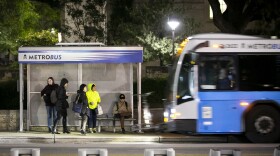Capital Metro says it has no way to determine how much money it lost from months of fare collection glitches that began in 2023 and culminated in a month-long outage last year. The transit agency cut ties with the company behind the malfunctioning system and launched a new fare platform this month.
CapMetro says the now-retired system is missing data, leaving "the total number of transaction attempts unquantifiable."
"Calculating the full extent of the fare revenue loss has been more complex and challenging than originally anticipated," CapMetro spokesperson Tawaun Cole said in a statement to KUT News. "Despite troubleshooting efforts, the data was unfortunately wiped from the system."
Riders frequently boarded for free after the upgrade that debuted in August 2023, months behind schedule. Bus drivers were eventually told to wave people on when scanners failed to process QR codes that riders would bring up on their phones to pay fares.
Problems reached a breaking point in March 2024. Fare validators went offline for more than a month. Capital Metro said it wasn't initially aware. Passengers who tapped their fare cards or scanned QR codes were given error messages like, "Validator offline, please board."
An internal May 2024 memo to CapMetro's board of directors — obtained by KUT News through a Texas Public Information Act request — said machines quietly stored more than 2 million ride transactions but never deducted fares from user accounts.
When the system finally reconnected in late April, it processed the backlog all at once. Delayed charges pushed some riders' balances into the negative. CapMetro issued refunds and fielded hundreds of complaints from confused and angry passengers.

At the heart of the meltdown, made public by KUT News last month, was technology supplied by Siemens, a vast German conglomerate active in everything from theme parks to military contracting.
In a blistering letter to Siemens, an attorney for the transit agency said the "the damages as a result of the service interruption period and ongoing nature of the issues are immeasurable."
The farebox upgrade became so problematic that CapMetro launched an emergency search for a different system. The replacement platform was rolled out to transit users this month.
But the agency now admits there's no way to know how many trips slipped through the cracks, either during the outage between March and April or in the months before and after.
The internal email to the board said about 5% of trips were missing during the month-long outage period. The agency's chief financial officer wrote that staff were working to determine how much money was lost, but expected it to be "de minimis," a Latin term meaning something lacking significance or importance.
In February, KUT News filed a request under the Texas Public Information Act seeking any internal analysis of lost fare revenue caused by the malfunctions in 2024. CapMetro responded that it had no such records.
In a statement, Siemens said it was “disappointed that our project with CapMetro has ended,” but noted the company still works with other transit systems across the country.
CapMetro says both sides signed a non-disparagement agreement before parting ways.

Fare collections make up a relatively small share of CapMetro's overall budget, typically between 3 and 5%. Fares amounted to more than $18 million in fiscal year 2024, which was about $500,000 below forecasted estimates. It's unknown how much of the shortfall was caused by fare collection glitches.
CapMetro's ridership has been steadily growing back since the pandemic. The transit agency is now recording about 75,000 boardings per day — slightly outpacing its own goals.
"I would say we're way ahead of our peers and kind of averaging between 88-90% of our pre-COVID ridership at the moment," CapMetro Executive Vice President Sharmila Mukherjee told board members at a meeting this month.
While CapMetro says the new payment system is more reliable, some users have reported issues on social media. That outcome is not uncommon when rolling out large-scale technology upgrades. Additionally, the agency's tap-to-pay technology was delayed because of security certifications required to transmit payment data wirelessly. But some riders have proven less willing to be forgiving after months of farebox frustrations.
So with no formal analysis and much of the data gone, the full financial impact of the old payment system's failures may never be known.
This story has been updated to include a comment from Siemens.






